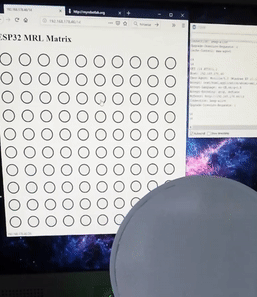|
#include <FastLED.h>
#define DATA_PIN 12 // change to your data pin
#define COLOR_ORDER GRB // RGB order
#define NUM_LEDS 101 // number of LEDs in your neo matrix
#define LED_TYPE WS2811
#define BRIGHTNESS 16
CRGB leds[NUM_LEDS]; //LED Array to store values
#define DELAY 150
#define SIZE 10
byte world[SIZE][SIZE][2]; // working array N.B. I designed this for "Conways Life" hence the strange declaration.
long density = 20;
int colour;
#include <WiFi.h>
int GETbar5;int GETbar6;int GETbarV; // variables for extracting X,Y coords
const char* ssid = "Your router id";
const char* password = "Your router password";
WiFiServer server(80);
String header; // Variable for HTTP request
void setup() {
Serial.begin(115200);
FastLED.addLeds<LED_TYPE, DATA_PIN, COLOR_ORDER>(leds, NUM_LEDS);
FastLED.setBrightness(63);
blank(); FastLED.show();
dispneo();
// Connect to Wi-Fi network with SSID and password
Serial.print("Connecting to ");
Serial.println(ssid);
WiFi.begin(ssid, password);
while (WiFi.status() != WL_CONNECTED) {
delay(500);
Serial.print(".");
}
// Print local IP address and start web server
Serial.println("");
Serial.println("WiFi connected.");
Serial.println("IP address: ");
Serial.println(WiFi.localIP());
server.begin();
}
void loop(){
WiFiClient client = server.available(); // Listen for clients
if (client) { // If a new client connects,
//Serial.println("New Client."); // print a message out in the serial port
String currentLine = ""; // make a String to hold incoming data from the client
while (client.connected()) { // loop while the client's connected
if (client.available()) { // if there's bytes to read from the client,
char c = client.read(); // read a byte, then
Serial.write(c); // print it out the serial monitor
header += c;
if (c == '\n') { // if the byte is a newline character
// if the current line is blank, you got two newline characters in a row.
// that's the end of the client HTTP request, so send a response:
if (currentLine.length() == 0) {
// HTTP headers always start with a response code (e.g. HTTP/1.1 200 OK)
// and a content-type so the client knows what's coming, then a blank line:
client.println("HTTP/1.1 200 OK");
client.println("Content-type:text/html");
client.println("Connection: close");
client.println();
//In this example we are setting up a webserver (webpage) with a 10x10 matrix
//When you select one of the cells in the matrix it outputs it to HTTP header
//This header can be parsed after reading it into a string buffer
// below I am using just the data from header position 5 and 6 , this relates to the referenced number of the mouse clicked character.
// this can just as easily be data for Switching LEDs/servo positions etcetcetc
GETbar5=header.charAt(5)-48; GETbar6=header.charAt(6)-48;
// -48 converts the ascii character into a number value (i.e. 48("0") to 59("9") to numeric 0 to 9), some jiggery pokery has to be done with numbers less than 10 due to no leading zeros, hence 2 line to account for this below. (-16 = a space detected i.e. originally ascii space 32(-48)=-16)
if ((GETbar6==-16)&&(GETbar5>=0)){GETbarV=GETbar5;}
if (GETbar6!=-16){GETbarV=(GETbar5*10)+GETbar6;}
world[GETbarV-(GETbarV/10)*10][GETbarV/10][0] = 1-world[GETbarV-(GETbarV/10)*10][GETbarV/10][0]; // invert the cell if ON switch OFF , if OFF swich ON (so you can draw onto the matrix real time)
// Display the HTML web page
client.println("<!DOCTYPE html>");
client.print("<html>");
client.print("<head>");
client.print("<style>h1{text-decoration: none;}</style>"); //format without any underline/crossthough/overlines
client.print("<style>a{text-decoration: none;}</style>");
client.print("<h1>ESP32 MRL Matrix</h1>"); // Title
client.print("<span style='font-size:50px;';text-decoration: line-through;>"); // Size of following Dots
for (int y =0; y < 10; y++) { // webpage output for a 10x10 grid of simple characters
for (int x =0; x < 10; x++) {
if (world[x][y][0]==0){client.print("<a href=\"");client.print((y*10)+x); client.print("\">⚪ </a>");} // 9898 This is just an empty circle character
if (world[x][y][0]==1){client.print("<a href=\"");client.print((y*10)+x); client.print("\">⚫ </a>");} // 9899 This is just an filled circle character
}
client.print("<br>"); // newline on webpage
}
client.println("</style></span>");
client.println("</body></html>");
client.println();
break; // Break out loop
} else {currentLine = ""; } // if newline character clear currentLine
} else if (c != '\r') {currentLine += c; } // if you got anything else add it to the end until carriage return
}
}
header = ""; // Clear the header variable
client.stop();// Close the connection
}
displayoutput(); // Display latest Neo pixel screen
delay(DELAY);
}
void displayoutput(){
for (int y = 0; y < SIZE; y++) {
for (int x = 0; x < SIZE; x++) {
if (world[x][y][0]>0){leds[(y*10)+x]=CRGB::Magenta; }
else {leds[(y*10)+x]=CRGB::Black;}
}
}
FastLED.show();
}
void blank(){
for (int y = 0; y < SIZE; y++) {
for (int x = 0; x < SIZE; x++) { leds[(y*10)+x]=0; }
}
}
void dispneo()
{
for (int y =0; y < 10; y++) {
for (int x =0; x < 10; x++) {
if (world[x][y][0]==0){;leds[(y*10)+x]=0;;} // 9899
if (world[x][y][0]==1){;leds[(y*10)+x]=CRGB::Green;;;} // 9899
}
}
FastLED.show();
}
|

